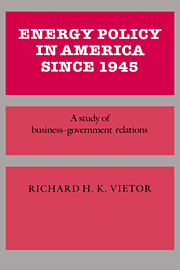Book contents
- Frontmatter
- Contents
- List of charts and figures
- List of tables
- Editors' preface
- Acknowledgments
- List of abbreviations
- 1 Introduction: The political economy of energy
- Part I The transition to peace and fluid fuels, 1945–1958
- Part II Managing surplus through the politics of stasis, 1959–1968
- Part III The second energy transition: adjustment to depletion, 1969–1980
- 9 Energy crisis and structural change
- 10 Equity versus efficiency: oil price controls
- 11 Natural gas: the dilemma of regulatory transition
- 12 Natural gas: the consequences of scarcity
- 13 National energy management
- 14 Business, government, and public policy
- Index
11 - Natural gas: the dilemma of regulatory transition
Published online by Cambridge University Press: 13 October 2009
- Frontmatter
- Contents
- List of charts and figures
- List of tables
- Editors' preface
- Acknowledgments
- List of abbreviations
- 1 Introduction: The political economy of energy
- Part I The transition to peace and fluid fuels, 1945–1958
- Part II Managing surplus through the politics of stasis, 1959–1968
- Part III The second energy transition: adjustment to depletion, 1969–1980
- 9 Energy crisis and structural change
- 10 Equity versus efficiency: oil price controls
- 11 Natural gas: the dilemma of regulatory transition
- 12 Natural gas: the consequences of scarcity
- 13 National energy management
- 14 Business, government, and public policy
- Index
Summary
Under the effects of cost-based regulation, it took just 20 years of rapid growth and low prices to transform natural gas from a near-effluent to a scarce commodity. The 1968 downturn in net additions to reserves marked the beginning of a difficult transition in natural-gas regulation. By 1974, service to industrial customers in interstate gas markets had been widely curtailed – reaching 16 percent nationally, and worse in some areas.
This chapter tells two interrelated stories. One is about regulatory process, and how adversary proceedings thwarted the Federal Power Commission's best efforts to change its regulatory standards. The other is about regulatory concepts, and how cost-based multi-tier rate regulation failed in a market of shortages and rising costs.
The adversary environment
When John Nassikas took over the chairmanship of the Federal Power Commission in August 1969, he announced that “What we need is a Nassikas round of gas rate increases.” That proved more easily said than done. In general terms, the political issues of gas pricing were similar to those for oil: mistrust and distributive equity. Much of the public and Congress believed that “Big Oil” had perpetrated the gas shortage intentionally. Thus, every decision by the Nassikas Commission was subjected to the closest congressional and media scrutiny for charges of ineptitude, impropriety, and unfairness.
But Nassikas faced an even greater challenge – surmounting barriers to change that the adjudicatory process and the weight of precedent imposed.
- Type
- Chapter
- Information
- Energy Policy in America since 1945A Study of Business-Government Relations, pp. 272 - 291Publisher: Cambridge University PressPrint publication year: 1984



